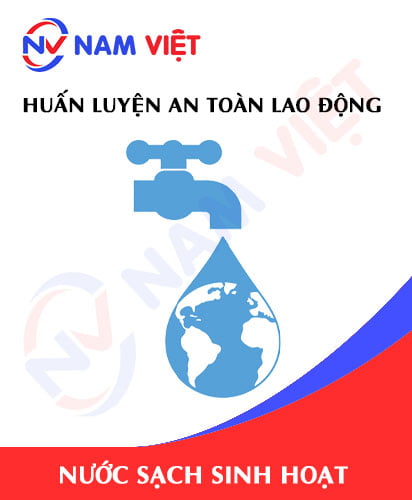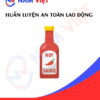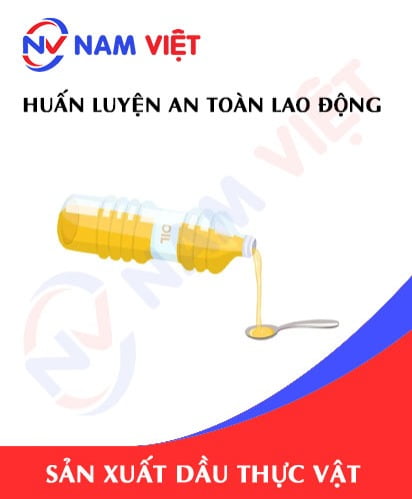Occupational Safety Training in Domestic Clean Water Manufacturing Factory
99,000 ₫
Note: The above price is calculated for one person and may fluctuate depending on the number of trainees participating in the course and market movements. For more accurate pricing support, please refer to the quotation table or contact our consulting staff directly.
Occupational safety is a critical issue in factories manufacturing domestic clean water and must be addressed promptly to ensure the health and safety of workers while enhancing the reputation of businesses. The Occupational Safety Training course is an effective solution to raise awareness among workers about accident prevention during domestic clean water manufacturing.
Table of Contents
Toggle1. Overview of domestic clean water
a. What is domestic clean water?
- Domestic clean water is water used for daily purposes such as drinking, cooking, personal hygiene, laundry, and cleaning in homes, schools, offices, and public agencies. Clean water is sterile, free of impurities, bacteria, viruses, or toxic compounds. This type of water is very important for the health of humans and living organisms on earth. Clean water can be produced through a water treatment process or collected from natural water sources such as ponds, lakes, rivers, or boreholes.
- According to the General Statistics Office’s report, the total amount of water supplied for domestic use in 2020 was about 6.26 billion m3, of which 2.58 billion m3 were produced by water treatment factories, with the remainder supplied from natural water sources.
- However, the supply of clean water in Vietnam has not yet fully met the needs of the people, especially in rural and mountainous areas. Many areas are still using groundwater that does not meet hygiene standards, posing a danger to people’s health.
- In addition, issues related to the management and monitoring of clean water quality also need to be improved to ensure that the quality of water produced and supplied meets the standards. Furthermore, applying advanced technology and optimizing the manufacturing process are also things that need to be focused on to improve manufacturing efficiency and minimize environmental impact.

b. Types of machinery for domestic clean water manufacturing
The types of machinery and equipment for domestic clean water manufacturing today include:
- Wastewater treatment system: Includes main components such as corrosion treatment tanks, organic decomposition tanks, settling tanks, ion exchange systems, activated carbon filters, organic sludge separation systems, bottom sludge separation systems, etc.
- Water pump: Used to supply water to the treatment system or directly supply clean water to the public. Common types of water pumps include booster pumps, wastewater pumps, submersible pumps, etc.
- Home water purifier: Can filter water directly from a clean water source or from a faucet, removing harmful substances and impurities, ensuring safe clean water for health.
- Industrial water purifier: Used for projects, buildings, and urban areas to produce clean water and supply it for domestic purposes.
- Water mixer: Used to mix the mixture in water treatment processes.
- Automatic control system: Ensures the system operates stably and achieves the highest efficiency.
- Water storage tank: Used to store treated or clean water, ensuring a sufficient supply of water and guaranteeing hygiene and safety for users.
- Piping system: Used to supply and lead water to usage points, ensuring the stability of water pressure and guaranteeing health for users.

c. Typical domestic clean water manufacturing enterprises in Vietnam
Typical clean water supply companies in Vietnam include:
- Sai Gon Water Supply Joint Stock Company (Sawaco)
- Ha Noi Water Supply Joint Stock Company (Hanoi Water)
- Da Nang Water Supply Joint Stock Company (Danang Water)
- Ho Chi Minh City Water Supply Joint Stock Company (Saigon Water Corporation – SAWACO)
- Thang Long Clean Water Joint Stock Company (Thang Long Clean Water JSC)
- Viwaco Group (Vietnam Water Corporation)
- Tan Hoa Water Supply Joint Stock Company (Tan Hoa Water Corporation)
- Binh Duong Water Supply Sewerage Environment Co., Ltd. (Biwase)
These companies mainly operate in the field of supplying clean water and treating wastewater for residential areas, industrial parks, and enterprises nationwide.
d. Specific jobs in a domestic clean water manufacturing factory
Group 1
- Executive director, deputy executive director, department manager in a domestic clean water manufacturing factory.
Group 2
- Safety officer: manages safety in the factory, designs safety procedures, supervises and urges employees to comply with safe work procedures.
Group 3
- Input water treatment: Here, water is filtered to remove harmful substances, impurities, bacteria, and other pollutants.
- Water processing: After being filtered, the water will be enhanced in purity and supplied to households, enterprises, or organizations for use.
- Quality control: A domestic clean water manufacturing factory must ensure that the water quality meets health, environmental, and human safety standards.
- Equipment maintenance and repair: The equipment in a domestic clean water manufacturing factory needs to be regularly maintained and repaired to ensure they operate efficiently and with high reliability.
- Factory operation management: Manufacturing activities need to be managed strictly and effectively to ensure manufacturing meets standards, safety, and efficiency.
- Implementing occupational safety and health regulations: Workers in a domestic clean water manufacturing factory must be fully equipped with personal protective equipment and comply with occupational safety regulations to ensure their health and lives.
Group 4
- Office work, service, sales, marketing.
- Manufacturing management, quality management, human resource management, material management, financial accounting management.
- Research and development of new products.

2. Overview of the occupational safety training course for domestic clean water manufacturing
In the scope of this article, we focus on issues related to Group 3, because Group 3 is the group directly involved in the manufacturing process, bearing the highest risk of occupational safety. Refer to other groups here
a. What is Group 3 occupational safety training?
- Occupational safety training for Group 3 are training sessions that equip workers with awareness of how to prevent workplace accidents.
- The occupational safety training course will help workers identify and avoid dangers, and limit the risk of workplace accidents during work.
REGISTER FOR OCCUPATIONAL SAFETY TRAINING SERVICES
b. Training duration
Initial safety training duration
- The total training duration is at least 24 hours, including exam time.
- 8 hours of theoretical study on the system of policies and laws on occupational safety and health
- 8 hours of theoretical study on basic knowledge of occupational safety and health
- 4 hours of theoretical study on specialized training content
- 2 hours of practical training on specialized training content
- 2 hours of theoretical examination at the end of the training course
The safety training center will distribute the time into multiple training sessions depending on the time arrangement for employees. But usually, there will be 6 training sessions, the course will take place over 3 days, on the condition that the manufacturing enterprise can arrange continuous study time.
Periodic safety training duration
- Before the occupational safety card expires, if workers want to have it re-issued, they must undergo a periodic occupational safety training course, with the periodic safety training duration being at least 50% of the initial safety training duration.
Explanation: The total periodic occupational safety training duration is at least 12 hours, including exam time. After completing the periodic training course and passing the exam, the worker will be re-issued or have their occupational safety card renewed.
c. Content of the training course
| No. | TRAINING CONTENT | TRAINING DURATION (HOURS) | |||
| Total | Of which | ||||
| Theory | Practice | Exam | |||
| I | System of policies and laws on occupational safety and health | 8 | 8 | 0 | 0 |
| 1 | Overview of the system of legal normative documents on occupational safety and health. | 6 | 6 | ||
| 2 | System of technical standards and regulations on occupational safety and health. | 1 | 1 | ||
| 3 | Specific regulations of state management agencies on occupational safety and health when building new, expanding, or renovating facilities for manufacturing, using, preserving, storing, and inspecting machinery, equipment, materials, and substances with strict requirements on occupational safety and health. | 1 | 1 | ||
| II | Basic knowledge of occupational safety and health | 8 | 8 | 0 | 0 |
| 1 | Basic knowledge of dangerous and harmful factors in the workplace. | 4 | 4 | ||
| 2 | Methods for improving working conditions. | 1 | 1 | ||
| 3 | Safety culture in manufacturing and business. | 1 | 1 | ||
| 4 | Rights and obligations of employers and employees; policies and regimes on occupational safety and health for employees; functions and duties of the occupational safety and health network. | 1 | 1 | ||
| 5 | Occupational safety and health rules, signs, safety and health guides and the use of safety equipment, personal protective equipment; skills and techniques for first aid for workplace accidents, prevention of occupational diseases. | 1 | 1 | ||
| III | Specialized training content | 6 | 4 | 2 | 0 |
| General knowledge of types of machinery, equipment, and substances that generate dangerous and harmful factors; analysis, assessment, and management of risks related to occupational safety and health, safe work procedures with machinery, equipment, and substances with strict requirements on occupational safety and health. | 6 | 4 | 2 | ||
| IV | Occupational safety training exam at the end of the course | 2 | 2 | 0 | 0 |
| Total | 24 | 22 | 2 | ||
See more training content for 6 groups
d. Occupational safety card
After completing the occupational safety training course and passing the exam, the worker will be issued an occupational safety card (in practice, also called the Group 3 occupational safety certificate).
Specifically, the Group 3 safety card will clearly show information such as: full name, date of birth, job, and specific working environment. It also includes the training duration, a red seal, and a signature confirming the completion of the training course.
According to the regulations on issuing safety cards specified in Clause 2 of Article 24 of Decree 44/2016/ND-CP, there are two cases:
- In the case where the employer and the employee have an employment contract with each other, the employer must sign, seal, and place an overlapping seal on the safety card for the trained person belonging to Group 3 after completing the training course from the occupational safety training unit and passing the exam.
- In the case where the worker is a freelance or seasonal worker, and does not have an employment contract, the training unit must sign, seal, and place an overlapping seal on the safety card for the worker after completing the training course from the occupational safety training unit and passing the exam.

3. Identifying dangers affecting workers when manufacturing domestic clean water
The dangers that can affect workers during the domestic clean water manufacturing process include:
- People working in a domestic clean water manufacturing factory are at risk of exposure to bacteria, viruses, and toxic substances. This can cause infectious diseases, allergies, or respiratory, skin, and eye problems.
- Equipment and machinery in the domestic clean water manufacturing process can cause accidents, injuring workers through impacts, cuts, or explosions.
- The use of chemicals and disinfectants can pose a toxic risk if not used and stored correctly.
- The equipment used in the domestic clean water manufacturing process can emit ultraviolet rays or X-rays, affecting the health of workers.
- Jobs related to domestic clean water manufacturing may require physical labor and long working hours, causing fatigue for workers.
4. Types of workplace accidents that often occur to workers when manufacturing domestic clean water
During the domestic clean water manufacturing process, workplace accidents can occur due to many causes, including:
- Chemical accidents: Chemical products used in the clean water manufacturing process, such as various types of caustic soda, detergents, chlorine, ozone, etc., can cause serious accidents if not used correctly or stored improperly.
- Electrical accidents: Electrical systems and equipment used in clean water manufacturing can cause electrical accidents if not regularly maintained or used correctly.
- Physical accidents: Manufacturing equipment, pipes, water storage tanks, and other accessories can cause physical accidents if not installed or used correctly.
- Other workplace accidents: Jobs in the clean water manufacturing process can cause other workplace accidents, including balance accidents, impact accidents, entanglement accidents, etc.
5. Safety measures when participating in domestic clean water manufacturing
Safety measures when participating in domestic clean water manufacturing include:
- Ensuring personal hygiene: Workers need to wear protective clothing and labor protection gear to avoid direct contact with liquids, chemicals, bacteria, and toxins.
- Using the correct protective equipment: Workers need to use the correct protective equipment such as gas masks, rubber gloves, and safety glasses to avoid being splashed with liquid and inhaling toxic chemicals.
- Waste control and treatment: To ensure the health safety of workers, waste needs to be controlled and treated correctly, including collecting, transporting, and treating waste in a safe manner.
- Advanced skills training: Domestic clean water manufacturing employees need to be trained with the necessary skills to minimize the risk of accidents and incidents. They need to be instructed on how to use equipment, methods for treating waste, and how to respond to emergency situations.
- Ensuring environmental hygiene: Domestic clean water manufacturing needs to comply with environmental protection regulations and ensure that all manufacturing processes are carried out correctly and safely for the environment.
- Performing periodic equipment maintenance and upkeep: Performing periodic equipment maintenance and upkeep is very important to ensure the operational performance of the clean water manufacturing system and minimize the risk of incidents.
- Ensuring safety in transportation and storage: The transportation and storage of clean water also need to be carried out in a safe and proper manner to ensure the quality of domestic clean water.
- Periodically organize workplace environment monitoring in factories and manufacturing plants, collect and analyze harmful factors to workers, thereby adjusting to reduce the level of harm to prevent occupational diseases for them.

6. Benefits of occupational safety training for domestic clean water manufacturing
An Toan Nam Viet provides your enterprise with excellent benefits after completing occupational safety training courses as regulated in Decree 44/2016/ND – CP on occupational safety and health work, Companies, manufacturing plants, enterprises.
- Employees can identify potential risks of workplace accidents and thus have preventive measures to avoid workplace accidents.
- Your enterprise can establish risk prevention measures in the manufacturing, operation, and maintenance processes.
- Minimize costs when occupational safety risks occur.
- Uninterrupted manufacturing will help increase labor productivity and product quality.
- Comply with occupational safety laws, avoiding legal risks.
- Build a professional reputation in all aspects, thereby enhancing your brand.
Nam Viet’s training courses are a solution to prevent and combat external factors from affecting each individual so that they can avoid danger that can lead to injury or, more seriously, death.
REGISTER FOR OCCUPATIONAL SAFETY TRAINING SERVICES
7. Customer feedback after completing the occupational safety training course for domestic clean water manufacturing
An Toan Nam Viet has many years of experience in the mission of accompanying many enterprises in Vietnam in general and in the southern provinces in particular. And that responsibility is something extremely precious to Nam Viet, which is why Nam Viet’s Occupational Safety Training work is increasingly focused on becoming professional. And the motivation for An Toan Nam Viet to grow strongly to this day comes from the positive feedback and suggestions from enterprises. Below are the feedbacks from our partners we have served.
Bac Nam E&C Investment and Construction Joint Stock Company
“The first time I used An Toan Nam Viet’s service, I was very surprised by the enthusiastic 24/7 support of the consulting team. The class organization was very quick and convenient for our company, thank you very much for Nam Viet’s service!”
Hoa Dat Construction and Trading Joint Stock Company
“Nam Viet’s service has helped us a lot in simplifying occupational safety and completing safety records for our work process. The consulting team is enthusiastic and timely in answering our questions. 5 stars for Nam Viet”
See more customer interviews after using An Toan Nam Viet’s service
8. Occupational Safety Training Competence of An Toan Nam Viet
An Toan Nam Viet is a reputable and quality occupational safety training center in Vietnam today. With occupational safety training sessions taking place continuously at manufacturing workshops, factories, or construction sites across the country (63 provinces and cities in Vietnam).
REGISTER FOR OCCUPATIONAL SAFETY TRAINING SERVICES
Giấy phép huấn luyện an toàn lao động
- An Toan Nam Viet has been inspected by the Department of Occupational Safety of the Ministry of Labor – Invalids and Social Affairs and granted a certificate of eligibility to operate occupational safety and health training. This further strengthens our ability to conduct occupational safety training.

Tài liệu và bài giảng
- Before occupational safety training documents are included in the occupational safety training courses, they are reviewed and censored to ensure that the lectures are always correct in terms of knowledge and effective when applied.
- The teaching method of the lecturers is synchronized according to the teaching standards of An Toan Nam Viet, which is a method that experts in occupational safety and health training have researched and summarized during the teaching process to bring the highest knowledge acquisition efficiency to students.
Cơ sở vật chất
- Controlling the factors in the classroom that affect the training process will increase teaching performance and the effectiveness of knowledge acquisition for students.
- Our facilities to support the training course always arrange spacious classrooms that meet standards for area, lighting, training equipment, etc.
9. Reputable and quality safety training center nationwide
At An Toan Nam Viet, we always put the professional dedication to occupational safety training as our top priority. For us, imparting the knowledge of self-protection to workers so that they can have a safe foundation on their career path is a contribution to building the country.
To ensure effective training, we prepare carefully and meticulously every little detail. From preparing tools, equipment, teaching devices to textbooks, documents, sound, and lighting.
Our occupational safety training lecturers are experts with many years of experience in the field. They even have research projects to identify hazards in all occupations and how to prevent them.
The lecturer’s lectures are summarized from reality and conveyed in the most vivid and easy-to-understand way to the workers. These factors help workers feel comfortable during their study time and absorb our teaching knowledge well. Of course, the knowledge conveyed always closely follows Decree 44/2016/ND-CP.
From there, they grasp many measures to prevent dangers and how to protect themselves. At the same time, they also apply it in the most suitable way in their actual work.
Our safety training center is proud to be a unit that provides reputable and professional occupational safety training services with the following advantages:
- Competitive training costs but training quality is still guaranteed.
- Flexible training schedule with the production situation of the Company or enterprise.
- Quick and legal procedures for issuing occupational safety training certificates.
- Training lecturers are people with many years of experience in the profession.
- The classroom is controlled for factors that affect the training process to increase teaching performance and the effectiveness of knowledge acquisition for students.
- The lectures are compiled to be suitable for occupational safety work at enterprises.
- An Toan Nam Viet works dedicatedly and professionally to support customers accurately and as quickly as possible.

10. Refer to more occupational safety training documents for domestic clean water manufacturing
- Occupational safety documents for domestic clean water manufacturing
- Set of occupational safety training documents
- Set of occupational safety training exam questions
- Multiple-choice exam for occupational safety for domestic clean water manufacturing
- Slides for the occupational safety training lecture on domestic clean water manufacturing
1 review for Occupational Safety Training in Domestic Clean Water Manufacturing Factory
No comments yet















namchinh.haiphong341
Dịch vụ tốt!!!